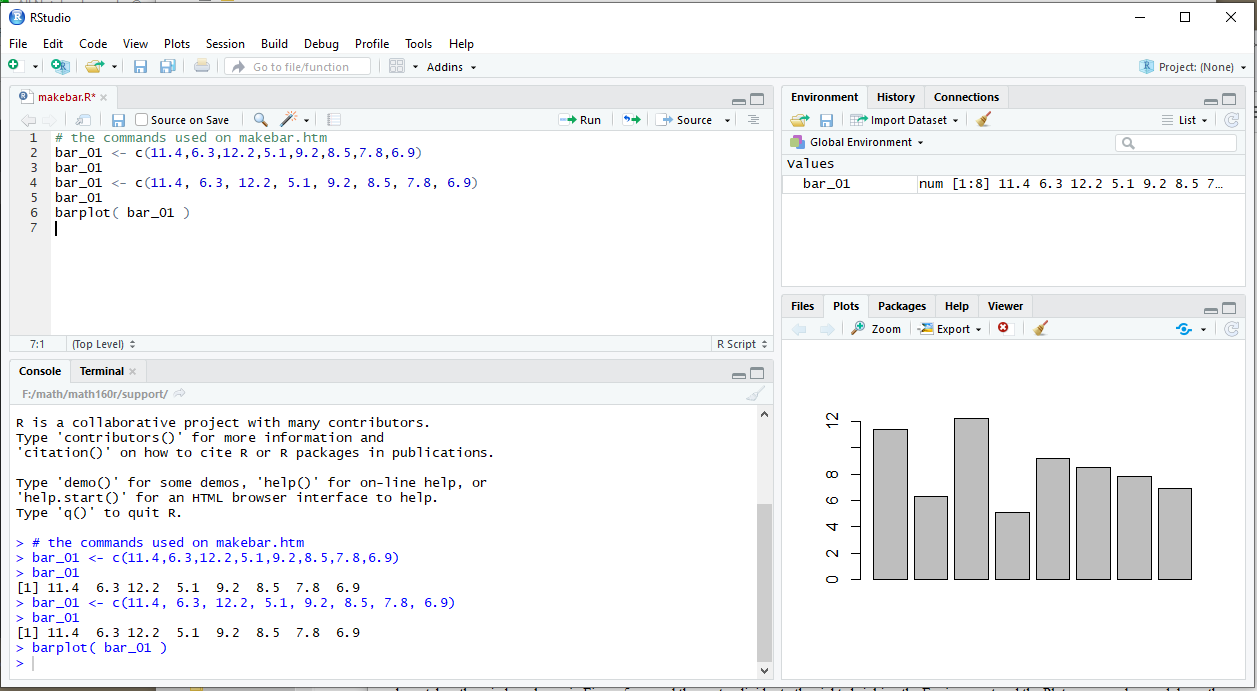
Here, col = "blue" changes the color of bars to blue. In the above example, we have used the col parameter inside barplot() to change the color of bars. In R, we pass the col parameter inside barplot() to change the color of bars. Here, we have assigned "Sun" to the first bar, "Mon" to the second bar and so on. In the above example, we have used the names.arg parameter to provide names to each bar of the bar plot.

We pass the names.arg parameter inside barplot() to provide names for each bar in R. Provide Names for Each Bar of Bar Plot in R ylab - provides the "Day" label for the y-axis.xlab - provides the "Degree Celsius" label for the x-axis.Here, we have provided additional xlab and ylab parameters to barplot() In the above example, we have provided labels for the x-axis and y-axis respectively. In R, we can also provide labels for the x-axis and y-axis. Here, the main parameter adds the title "Maximum Temperatures in a Week" to our bar plot. barplot(temperatures, main = "Maximum Temperatures in a Week") In the above figure, we can see that we have added a title to the bar plot of the temperatures vector. To add a title to our bar plot in R, we pass the main parameter inside the barplot() function. The bar plot we have created above is plain and simple, we can add so many things to the bar plot. In the above example, we have used the barplot() function to create a bar plot of the temperatures vector. In R, we use the barplot() function to create bar plots. It can be used to summarize large data in visual form.īar graphs have the ability to represent data that shows changes over time, which helps us to visualize trends.

**I didn't state this earlier and it's honestly not NEEDED, but I was also interested in the presence of a species of mite and a species of spider.ĮDIT: folks, I was finally able to construct proper graphs.Bar Plots is one of the most efficient ways of representing datas. I basically am just curious to know how I can go about properly merging these dependent variables.Īll help is appreciated and if a reprex is needed, I will try my best to get one posted when I get back to my desktop in the next 2 hours or so.Įdit: I just deleted my initial post, as the title was incorrect

The labels are thrown away and I'd like to keep these. Instead of the legends corresponding to the proper label, they're actually corresponding to the combined values.įor example, if my dependent variables were 'banana, poacee, sorgo, and triticum with 0,1,0,3 for banana 1,4,1,5 for poacee 0,0,0,0 for sorgo and 1,8,0,1 for triticum, It would end up just combining those numbers and look something like this for the legend: After 'merging' the columns, the initial titles of each of the combined columns are essentially 'thrown out' and the merged values are left behind under the new name for the column. I've attempted paste, unite, pivot and melt functions, but I guess I'm doing it wrong.
R studio commands to make a bar graph code#
I have about 6 dependent variables (each is a species of plant) that I would like to merge, but for some reason, I don't think I'm getting the code right.

I would try and post a reprex or something if needed, but am limited since I'm away from the data set at the moment. If this is not the way to go, I would appreciate being pointed in the right direction. Basically, I'd like to plot out graphs like the ones attached and have it where fill corresponds to the new column of combined dependent variables (I hope that this makes sense).


 0 kommentar(er)
0 kommentar(er)
